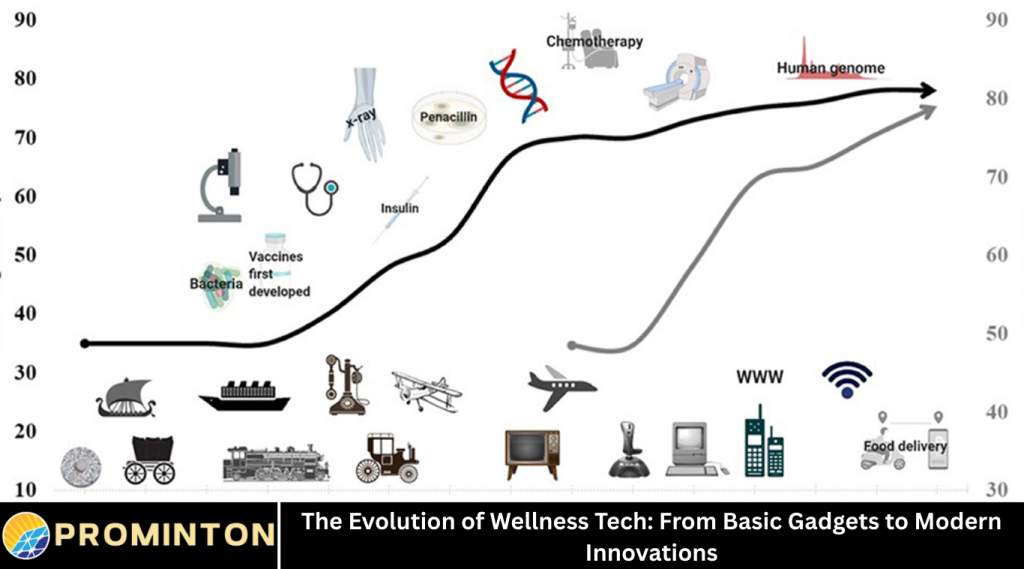Wellness technology has come a long way. What began as simple mechanical devices to aid fitness or relaxation has grown into a vast ecosystem of biometric sensors, AI‑driven platforms, immersive experiences, and predictive analytics.
In this article, we’ll explore how wellness tech has evolved—from early devices and turning points, to the current state, and where things seem to be going. We’ll look at technological, cultural, and scientific shifts; discuss the major innovations; highlight the challenges; and examine what lies ahead.
Early Wellness Gadgets: The Foundations
Mechanical and Analog Era
In the beginning, wellness devices were non‑electronic, purely mechanical or analog:
- Gym machines and weightlifting equipment were designed for strength training; pulleys, resistance weights, ropes, etc.
- Simple analog pedometers: count steps or measure basic movement (mechanical spring‑based or basic electronic later).
- Manual bathroom scales to measure body weight.
- Analog timers or hourglasses for timing exercises or rest.
These tools were useful but limited. They offered feedback only in discrete moments (e.g. after stepping on a scale), with no continuous monitoring or data retention.
First Electronic Devices
With the advent of affordable electronics in the late 20th century:
- Digital pedometers and heart rate monitors (often chest straps) emerged. They could provide more accurate counts of steps and heart rate during exercise.
- Basic calculators, timers, and even early home exercise machines with simple digital displays (e.g. treadmill consoles showing speed, distance).
These devices made exercise monitoring more precise, but they were still isolated: the data lived on the device, not shared or analyzed much beyond its immediate reading.
Turning Points in Wellness Tech
Several technological and social developments significantly accelerated the evolution of wellness tech.
Miniaturization and Improved Sensors
As sensors (for heart rate, motion, temperature, etc.) became smaller, cheaper, and more power‑efficient, they could be embedded in wearables, clothing, and even accessories. This miniaturization enabled continuous monitoring—vital for tracking trends over time (sleep cycles, heart rate variability, etc.).
Wireless Connectivity and the Internet
Bluetooth, Wi-Fi, and later mobile internet made it possible for devices to transmit data to smartphones or to cloud servers. Users could see trends, get alerts, compare data, share with apps. This connectivity is essential for modern wellness technology.
Mobile Devices and Apps
The rise of smartphones not only created a platform for companion apps for wellness devices, but also became wellness devices themselves (through built‑in sensors, apps for meditation, nutrition, mental health, etc.). People began accessing guided workouts, mindfulness sessions, dietary trackers, and sleep‑tracking apps directly through their phone.
Advances in Data Science, AI & Algorithms
Collecting data is one thing; making sense of it is another. Machine learning, AI, predictive analytics made wellness tech more useful. Rather than just reporting “you took 6,000 steps today,” modern systems can advise: “your recovery seems low; you might want to rest more,” or “your sleep quality is suffering due to irregular schedule.”
Rising Demand for Preventive, Holistic, and Personalized Wellness
Cultural shifts toward preventive healthcare and holistic wellness (physical, mental, and emotional) increased demand. People no longer want to wait until sickness; they want to optimize performance, maintain health proactively, reduce stress, ensure good sleep, maintain mental wellbeing. That demand pushed technology to respond with more personalisation and integration.
From Basic to Modern: Key Innovations
Let’s trace some of the innovations and breakthroughs in wellness tech over recent decades, showing how they build on earlier gadgets.
Wearables & Smart Sensors
- Fitness trackers & smartwatches: These are among the most visible wellness tech today. Modern ones do much more than step‑counting: they monitor heart rate, blood oxygen saturation, stress signals (heart rate variability), sometimes even glucose levels. They track sleep stages, recovery, and sometimes workouts automatically.
- Smart rings and biometric jewelry: More discreet, these often focus on sleep and recovery metrics. They may offer continuous monitoring with lower energy use and small form factors.
- Smart textiles & clothing: Clothing embedded with sensors to measure things like body temperature, movement, muscle activation. For example, to monitor posture, hydration, or performance during workouts without needing separate devices.
Remote Monitoring & Telehealth
- Devices that allow long‑term monitoring of chronic diseases or health conditions in non‑clinical settings (e.g. at home). These can send data to providers, trigger alerts, and support remote care.
- Telehealth platforms: virtual consultations, coaching, diagnostics without needing physical visits. Especially important for mental health, nutrition, physical therapy.
AI‑powered Personalization & Predictive Analytics
- Wellness apps now use artificial intelligence or machine learning to interpret large datasets from wearables, lifestyle, medical tests to give personalized advice.
- Predictive tools: for example, systems that might predict deteriorating sleep quality, risk of chronic disease, or recommend preventive measures based on identified patterns.
Immersive & Experience‑based Tech
- Virtual Reality (VR) and Augmented Reality (AR) are being used for things like guided meditation, immersive therapy, fitness classes. They offer more engaging experiences.
- Smart mirrors: devices that reflect more than your image—tying in sensors, providing feedback, health stats, virtual coaching. A recent example: Withings’ Omnia concept mirror which measures weight, metabolic health, heart health, pulls in data from wearables, gives feedback via voice assistant, etc.
Sleep, Mental Wellness, and Recovery Tech
- Sleep trackers, tools to improve sleep (weighted blankets, masks, ambient sound, etc.). Sleep has become recognized as central to wellness.
- Mental wellness platforms: apps for meditation, mindfulness, stress tracking, mood monitoring. AI chatbots, virtual assistants that support mental health are more common.
- Recovery tools: infrared / red light therapy, sauna or heat therapy, cold immersion (ice baths), massage guns, whole‑body vibration devices.
Current State: Key Trends in Wellness Tech (2024‑2025)
Here are some major trends dominating wellness technology right now:
Deeper Biomonitoring & Health Metrics
Devices are monitoring more specialized biomarkers—sleep quality, HRV (heart rate variability), continuous glucose monitoring, oxygen saturation, etc.
Personalization & AI Guidance
Rather than one‑size‑fits‑all, systems are increasingly using user data (behavior, biomarkers, preferences) to tailor recommendations.
Holistic Wellness, Mental Health & Recovery
Mental health, stress reduction, recovery (sleep, rest) are no longer “nice to have” extras—they are integral components of any wellness offering.
Consumers increasingly expect wellness products to be environmentally responsible: biodegradable packaging, refillable skincare, plant‑based nutrition.
Immersive, Engaging Experiences
Using VR/AR, gamification, virtual classes or experiences; wellness is becoming more than just functional, it’s experiential.
Preventive & Predictive Health
Wellness tech is shifting from reactive (fix when there’s a problem) to proactive (identify risks early, maintain baseline health)
Challenges, Risks & Ethical Considerations
With great innovation come challenges. Some key ones include:
- Privacy and Data Security: Collecting detailed biometric and health‑related data raises privacy risks. Where and how data is stored, who has access, and for what use must be carefully managed.
- Regulation & Medical vs Wellness Device Distinction: Many devices live in a gray zone between “wellness” and “medical device.” Medical devices often require stricter validation, regulatory approval, safety standards. Distinctions aren’t always clear.
- Accuracy and Validity: Not all devices are accurate. Misleading or incorrect readings can lead to bad decisions or unnecessary anxiety.
- User Engagement & Behavior Change: Technology can enable, but long‑term behavior change is hard. Many users abandon devices or apps after initial enthusiasm.
- Accessibility & Equality: Costs, digital literacy, and availability can leave many people out—both in developed and developing regions.
- Over‑dependence + Psychological Effects: Too much tracking or obsession with metrics can negatively impact mental health, lead to anxiety, or an unhealthy focus.
Case Studies & Representative Devices
To illustrate how far we’ve come, here are a few notable examples or case studies:
- Technogym: Starting in the 1980’s with strength equipment, evolving into connected fitness platforms (e.g. MyWellness Cloud) where gym, home, hotel use is integrated.
- Bellabeat: A company producing smart jewelry / wearables that monitor wellness metrics (menstrual cycle, sleep, activity) while also being fashion‑oriented.
- The 100K Wellness Project: A longitudinal study combining genomic, microbiome, clinical lab, and personal wellness tracking to deliver actionable insights to participants. Demonstrating how data integration can meaningfully affect well‑being.
- Withings’ Omnia Smart Mirror: A concept device that pulls together many wellness metrics (weight, metabolic health, heart health) and provides feedback and virtual consultation via voice assistant.
What’s Next: Future Directions
Looking ahead, here are trends and innovations likely to shape wellness tech in the near to medium term.
Digital Twins & Virtual Avatars of Health
There is growing research into “digital twin” models of human health—virtual replicas of physiological state drawn from continuous data that can simulate what‑if scenarios (What happens if I change diet, sleep, stress, etc.).
More Integration Across Domains
Integration between nutrition, mental health, physical fitness, recovery, sleep—with seamless data sharing across devices and platforms. Systems that understand your full health context and make cross‑domain suggestions.
More Sophisticated Predictive Analytics
Early detection of disease risk, more precise personalization, hooking in genomics, epigenetics, biomarker panels, and more. Preventive health becoming more actionable.
Enhanced Immersive & Mixed Reality Experiences
AR/VR for therapy, fitness, meditation; possibly combining biofeedback and immersive simulations. Think virtual coaches, virtual nature immersion, etc.
Affordable, Transparent, & Equitable Tech
Price reduction, better accessibility; clearer regulation and standardization; open data and user control over privacy. More inclusivity: age, gender, socioeconomic status.
Sustainability & Ethical Design
Devices that are energy efficient, materials that are sustainable, packaging, and business models that reduce environmental footprint. Also, attention to ethical issues like bias in AI, overreach in data use.
The Impact on Individuals & Society
- Empowerment: Individuals have more control over personal health, better information, more tools to shape well‑being.
- Healthcare System Relief: With preventive care, remote monitoring, and better early warning, there’s potential to reduce burden on clinics and hospitals.
- Shift in Mindset: Health becomes more continuous rather than episodic; wellness is more than absence of disease: includes mental, emotional, social well‑being.
- Potential for Digital Divide: Unless inclusion is built in, some will benefit far more than others.
- Cultural Change: Tech shapes norms about fitness, rest, self‑care, mental health. What was once niche (e.g., meditation apps, red‑light therapy) becomes mainstream.
Frequently Asked Questions
What counts as “wellness technology”?
Wellness technology includes any tech device, platform, app, or system designed to improve, monitor, or support physical, mental, or emotional health, fitness, recovery, or general well‑being. This covers wearables (fitness trackers, watches, biometric rings), mental health apps, sleep‑monitors, recovery tools, telehealth platforms, AI coaching, etc. It does not always mean medical devices; many are consumer grade and focus on wellness rather than treating disease.
How accurate are wellness devices (like wearables) compared to medical grade equipment?
Accuracy can vary widely. Consumer devices are improving, but they often trade off some precision for convenience, cost, or battery life. Some readings (heart rate, step count) can be quite good; more complex measures (e.g. continuous glucose monitoring, sleep‑stage detection, metabolic rate) are less reliable unless validated. Also, algorithms differ, so two devices measuring the same metric may produce different numbers. It’s wise to use wellness devices for trends, awareness, motivation—not as replacements for medical diagnoses.
Is wellness tech just a fad, or will it continue to grow?
Evidence suggests wellness tech is here to stay and will continue to grow. Market trends show increasing consumer demand for personalization, mental health tools, sleep technology, and preventive/predictive health. Regulatory and scientific advances are closing gaps. The integration of AI, remote monitoring, and immersive experiences point to longer‑term adoption. However, some tools or “fads” might fade (novel gadgets that don’t deliver benefit), while others will become standard.
What are the privacy and ethical concerns with wellness tech?
There are several:
- Data privacy: sensitive health and biometric data must be securely stored, encrypted, and used with user consent.
- Ownership: who owns the data? The user, device manufacturer, or service provider?
- Misuse: health data could be used in unintended ways (insurance, employment discrimination).
- Bias in algorithms: AI tools may be trained on limited datasets, leading to bias or inaccuracy for certain populations.
- Over‑surveillance or over‑tracking: continuous monitoring might cause anxiety or encourage obsessive behavior.
How can wellness tech be made more accessible and inclusive?
Some strategies include:
- Designing devices/apps with affordability in mind, creating lower‑cost models.
- Ensuring usability for older adults, people with disabilities, or low tech literacy.
- Using local languages, simple interfaces, inclusive design.
- Ensuring equal access to broadband/internet where needed.
- Transparent pricing, supporting insurance or health service reimbursement where possible.
What kinds of wellness tech are most promising right now?
Some of the most promising include:
- Biometric wearables that give more comprehensive metrics (HRV, glucose, etc.).
- AI‑driven personalized recommendations across fitness, mental health, nutrition.
- Remote patient monitoring for chronic conditions.
- Digital twin models of health.
- Immersive VR/AR experiences for therapy, fitness, mental well‑being.
- Sleep technology: tools to improve sleep environment, tracking, guidance.
- Recovery technologies: light therapies, cold immersion, etc.
How should someone decide which wellness tech tool to use?
Here are some guidelines:
- Define your goal: Do you want better sleep? Less stress? More fitness? Track specific biometrics?
- Validate accuracy if important: Look for devices or apps with studies or validation.
- Ease of use: Battery life, comfort, user interface, whether the data integrates well with your other tools.
- Privacy policy & data security: Who holds your data, how it is used.
- Price vs benefit: Some tools are expensive; consider whether the benefit is worth cost.
- Longevity & support: Will the product be supported/updated in future? Is the company credible?
Conclusion
The journey of wellness technology is one of increasing sophistication, from simple tools and early electronic devices to AI‑driven systems, immersive experiences, and integrated platforms. As technology continues to evolve, the possibilities are exciting—but they must be balanced with ethics, accessibility, accuracy, and user‑centered design. Ultimately, wellness tech has the potential to support healthier, more balanced lives, but only if used wisely.



